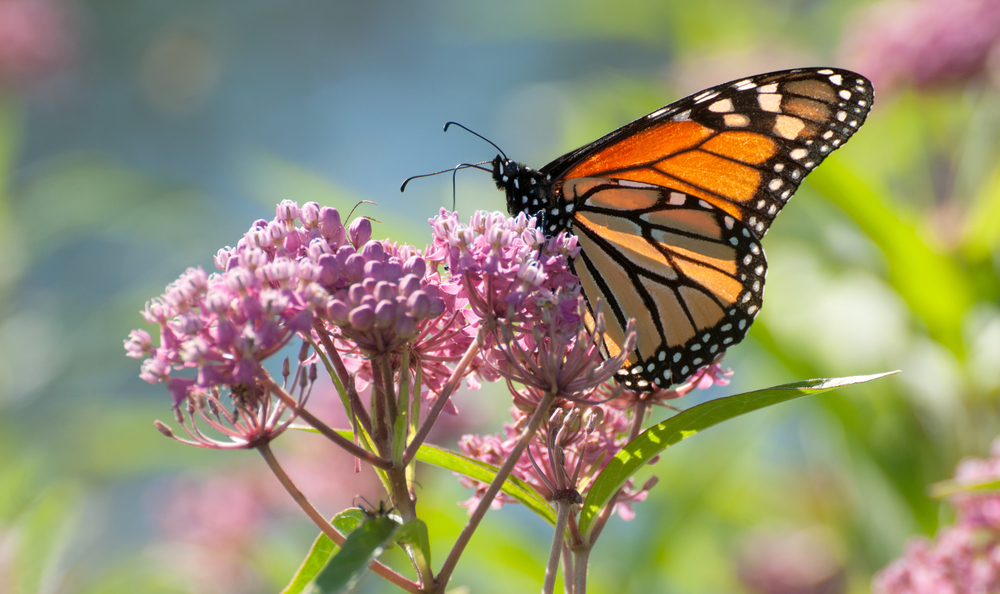 Monarch butterflies are one of many amazing butterfly species that spend time in Florida and create lasting memories for our families.
Monarch butterflies are one of many amazing butterfly species that spend time in Florida and create lasting memories for our families.
Recently, they joined the endangered species list and are inching ever closer to extinction. In the past decade, these beautiful creatures have faced increasing challenges due to deforestation, wildfires, and herbicides that eliminate vital protections for the species. You may be surprised to learn that Florida is an instrumental part of these storied butterflies’ migration. In fact, monarch butterflies time their departure from Mexico to ensure they arrive during Florida’s optimal growth season of milkweed, as our state is home to 21 native species of milkweed. In recent decades, however, areas that were previously flush with native milkweed are thinning out, largely due to development and agriculture practices.
Milkweed is not just a source of food for the monarch butterfly. It serves the butterfly during the most fragile stages of its transformation, providing a habitat in which they can lay their eggs, cultivate their chrysalis, and become potion masters in a sense that would make Professor Snape proud.
Unfortunately, monarch butterflies do not naturally have a toxic defense against predators. They eat the milky substance inside the milkweed (known as galitoxin) as young butterflies to protect themselves from predators. Who knew there was a wizarding world of butterflies? There is! The bad news is that its version of Hogwarts is under attack.


How You Can Help
Taking a simple action step like creating a Florida-friendly garden bed can help. Florida-friendly gardening focuses on planting varieties that are native to Florida. There are so many perks to using native plants — they tend to be drought tolerant, low maintenance, and wildlife friendly. You can start small by picking a location for a flowering bed, clearing it of non-native plants, and planting milkweed along with some other Florida-friendly plants.
My favorite variety of milkweed for my backyard is called swamp milkweed. It does require a little more water than butterfly milkweed or common milkweed, but what sets swamp milkweed apart for me is that it grows in a clump and that clump fans out from a single center point. Butterfly milkweed and common milkweed grow straight up from the rhizomes. This means that those varietals could pop up in unexpected locations in your yard. Swamp milkweed steadily gets larger but stays put. It’s important to remember that this plant is toxic to both pets and people. I like to plant it in the center of a bed with non-toxic plants surrounding it. This provides distance from the milkweed flowers when they are in bloom to prevent accidental interactions with pets or little ones.
Swamp milkweed is beautiful in bloom, often found with pink, white, or orange-tinged flowers. It brings an abundance of butterflies and pollinators that will beautify your whole garden. As beautiful as it is in bloom, it is equally unattractive as it goes to seed. This is true of all milkweeds. Milkweed is often called leggy in gardening magazines. I’ve learned that this means when your butterfly garden is thriving at some point, this plant goes from gorgeous to resembling a stick covered in circular fluff balls. Because of this, one of the gardening nicknames for milkweed is “hairy balls” — cue all the jokes. Sometimes that name is used right on the seed packet. It can be hard to imagine during these times that this plant is surviving much less thriving, but it is. It just needs a reliable friend to stand up for it during its dramatic changing seasons. Some of my favorite companion plants for milkweed are butterfly bush, purple salvia, mammoth sunflowers, highbush blueberries, and golden rod.
Florida is the birthplace of many of the world’s monarch butterflies. With their numbers dwindling, it is more important than ever that we do what we can to help. Planting native milkweed and Florida-friendly companion plants can help provide them with a strong start. Every little bit helps.
Click here for more tips on how to start a butterfly garden with your children.
















